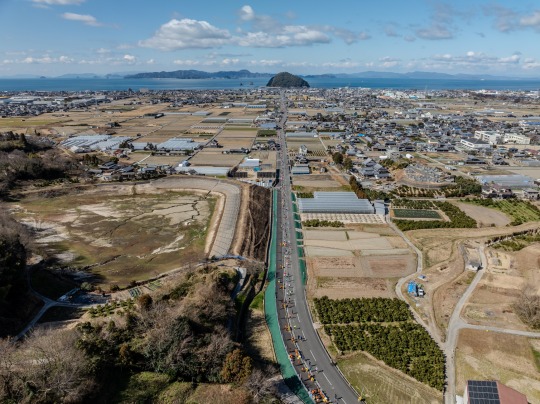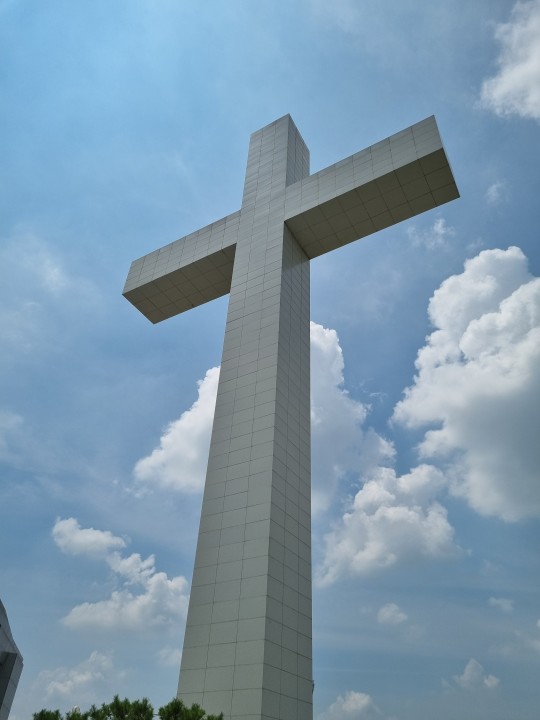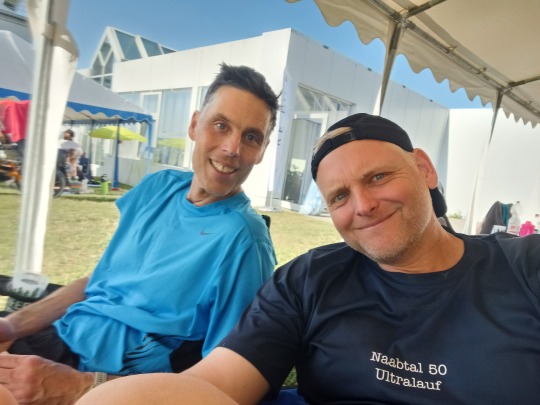#42.195
Explore tagged Tumblr posts
Note
When was Sam's last marathon, and how many miles was that?
A marathon always has the same distance anon, that's why it is called a marathon. It's always 26.2 miles or 42.2 km. To be even more exact, it's: 26.218 miles, or 26 miles and 385 yards. 42.195 kilometres, or 42,195 metres.
No one seems to agree on where this exact number originated but for what it is worth:
It all started in ancient Greece with an Athenian runner named Pheidippides, who was a messenger for the Athenian army. He could run for hours and hours and rumour has it he once covered 155 miles through the Greek countryside in only 36 hours! The part we are most interested in is his last job. Pheidippides had to run from the battlefield in a small town called Marathon to the citadel in Athens, a distance of about 40kms, or nearly 25 miles, to announce the Greeks victory over the invading Persian army. He completed his mission, gave the message and then died. Rumour has it that his last words were ‘my feet are killing me’. To commemorate his impressive and dramatic run, the 1896 Olympic marathon in Athens was set at 40 kms. Marathons remained a distance of 40kms until the 1908 Olympic games in London. This is where we find the answer to our unusual race distance. Queen Alexandra, the ruling British monarch of the time asked that the race start on the lawn of Windsor Castle (so the smallest royals could watch from the window of their nursery) and finish in front of the royal box at the Olympic stadium—a distance that happened to be 26.2 miles (26 miles and 385 yards). Some years later the length for a marathon was formally standardised at 26.2 miles (42.195kms)
source
Sam's marathons:

he signed up twice for NYC as well, but both times that marathon got canceled, in 2012 because of superstorm Sandy and in 2020 due to Covid.
25 notes
·
View notes
Text
2025 London Marathon! 🏃


If SH complains about being so tired before starting the London Marathon, he certainly does not face stiff competition from Cardio Dino 😅
Never too old (nor extinct) for a good cardio sesh 🦖 The T-Rex will makes an appearance at the London Run and will carry him through 26.2 miles which is equivalent to 42.195 km across the capital. What a day! 🫢
Good luck everyone! 🏃+ 🦖
Posted 27th April 2025
3 notes
·
View notes
Text
The Math of Outer Wilds
Outer Wilds is a lovely game that takes place in a scaled down solar system complete with tiny planets, tiny day-night cycles, and travel time that is blisteringly fast for ships held together with duct tape. But as any Outer Wilds fanfic writer knows, this scaling down leaves time and distance... wonky.
So I decided to actually run the numbers of how Hearthian distance and time compares to ours. Fair warning, I am not a mathematician, but I'll be explaining my logic and calculations as I go so folks can double check my work. I also apologize deeply to anyone who reads this and then needs to stare at a wall for an hour or two to process just how fucked up Hearthian everything is compared to human measurements; I highly recommend never, ever using these numbers in your writing unless you want to cry.
Let's dive in!
First order of business was calculating from a constant to get a conversion of Hearthian kilometers to human kilometers. I wanted to use the speed of sound from the supernova but sound doesn't travel in space in real life, unlike in game, so I had to use something else. I settled on the general speed a supernova ejects matter at: between 15,000 and 40,000 kilometers per second. I took the lowest value, 15,000, to be as nice to the Hearthian distance system as possible.
The Hearthian star supernova travels at a speed of about 0.812 kilometers a second (I sat my ship on the white hole station about 23 Hearthian km from the sun to watch and my stopwatch recorded it to take 28.32 seconds for me to die). Taking this value, I can then set up a ratio of Hearthian kilometers to Human kilometers: 23 H km to 424,800 hu km, totaling to 18,469.57 human kilometers for 1 Hearthian one. That means, for example, when Giant's Deep is roughly 16.5 Hearthian kilometers from Timber Hearth at the start of the loop, the human distance would be 304,747.905 human kilometers.
So now that we have a good conversion to work off of, let's take a closer look at Timber Hearth, the home planet of Gabbro, Chert, and the rest of the Ventures crew.
By shooting my scout on top of the Zero-G cave such that it's level with "sea level" on the planet then heading down the elevator into the center of the planet, I was able to tell that the distance between the planet's surface and the central point of the planet is to be about 256 Hearthian meters, or about 4,728.21 kilometers in human units. This means that in diameter, Timber Hearth is 9,456.42 human kilometers wide. For reference, Earth is about 12,742 human kilometers wide. This puts Timber Hearth as being just slightly smaller than Earth but bigger than Mars.
Let's go further. The circumference of a circle is calculated with 2*pi*the radius. The radius of Timber Hearth is 4,728.21 kilometers, putting the planet at a circumference of 29,693.16 kilometers. To get from North pole to South pole, a Hearthian would need to walk over 14,000 kilometers, to get from the village to Young Bark crater, about 7,400 human kilometers.
For curiosity's sake, I walked that distance with my little Hearthian traveler and it took me 2 minutes and 30 seconds roughly to walk from North to South pole, including time to navigate around geysers and get up and down the crater walls. I also sat there with my stopwatch and found the Hearthian day-night cycle to take about 8 minutes to go from dawn to dawn. One, this means that in Hearthian time, the loop spans a little less than 3 days, and two, the Hearthian day-night cycle in no way matches distances.
By the Hearthian day-night cycle, I could set off from one pole at dawn, travel over 14,000 kilometers by Earth units, and arrive at the other pole by dusk. That... is implausible. At best.
On Earth, a marathon is 42.195 kilometers and on average, it takes a person 4 hours and 30 minutes to complete it. Expanding on this number, assuming no time is taken for sleep, it would take about 352 hours, or two weeks, to walk from one pole to the other. To get from Timber Hearth to either pole, a week and a few days-worth of sleep of Earth time. These numbers do actually sound plausible. I would 100% believe it would take a month or two to circumnavigate Timber Hearth.
Something else to consider is that Nomai technology is truly incredible, as is the material Timber Hearth is made of. The deepest mine on Earth is roughly 4 kilometers deep, the deepest on Timber Hearth is a whopping 4,728.21 kilometers deep, right down to the center of the planet! This means that the structural integrity of Timber Hearth stone is insane as it's able to hold the shape of the tunnels for thousands of years, beneath the much of the weight of the planet above, without collapsing. No wonder the Nomai used Hearthian rock for the Ash Twin project! And how incredible their technology must be if they were able to mine it en masse, too.
Makes one wonder about the power of those Hearthian mining machines like the one to be fixed in the Zero-G cave, huh? Perhaps it's not such a stretch after all that Slate started making rockets if that's the kind of machinery they were working with beforehand. And the speed those rockets must be able to obtain is just as crazy!
One thing this revelation about distances does is tell us that the protagonist probably spent a lot less time walking across the surface of various planets during the loop than the average player does. Their ship was almost certainly the primary means of travel for our Hearthian and walking was reserved for checking out points of interest that were scouted from space. Beyond this, those gravity tunnels on Brittle Hollow? Those must have been blisteringly fast in order to get across the planet so quickly, no wonder it's so easy to pancake yourself with them.
Another thing it tells us is that all those stories where Gabbro or any other Hearthian makes a day trip to the quantum grove is unlikely to have actually occurred that way, as it would take a lot longer to travel Timber Hearth. The same goes for Tektite and their trip to Youngbark crater- which poses a problem.
The game itself explicitly states that Tektite only took a little while to get from the Hearthian village to go see the disturbance in the crater, an amount of time implied to be less than a few days even. This runs contrary to what is actually possible for a Hearthian to do on foot... Unless Gossan has a ship of their own and uses it to ferry passengers around Timber Hearth. Or Tektite used a tunnel under the planet's crust to shorted the amount of time it takes. Or they're just cool like that, haha.
The main takeaway from all of this is that Outer Wilds is a game about exploration and wonder and as such, trying to make everything make sense is a wonderful way to make your brain start glitching. Numbers are just a tool for a writer or artist to use as a suggestion, not a hard and fast rule, so have fun with it and don't get bogged down in the details!
Unless you're like me and your idea of fun is overanalyzing media at 4 am. Don't be like me.
(Help.)
41 notes
·
View notes
Text


🌅 Capture the Spirit of the 2025 Ehime Marathon 🌅
🏃♂️ The 62nd Ehime Marathon is here! Happening Sunday, February 9, 2025, this iconic race takes runners through the stunning landscapes of Matsuyama City, Ehime Prefecture. From scenic coastal roads to vibrant urban streets, it’s an experience you don’t want to miss.
Event Details:
📏 Distance: Full Marathon (42.195 km)
⏳ Time Limit: 6 hours
🎽 Participant Capacity: 10,000 runners
💰 Entry Fee: 20,000 yen
🎁 Finishers’ Prize: Exclusive Imabari towel & certificate
📸 Experience the Marathon in Stunning Detail!
🌍 Images Available on Alamy: High-resolution photos capturing the energy, landscapes, and culture of the marathon. Perfect for editorial use or promotion.
🔗 Find the Collection: Alamy Portfolio
🎥 Videos Exclusively on Pond5: Bring the race to life with aerial footage showcasing Matsuyama’s breathtaking scenery.
🔗 Explore Videos: Pond5 Portfolio
🗺️ Course Highlights:
🏞️ Certified “Yuttari Orange Road” course.
🎉 Finish Line: Shiroyama Park.
🏰 Stunning views of Matsuyama Castle and the surrounding region.
📅 Runner Registration:
📍 Location: Shiroyama Park, Horinouchi
📆 February 8, 1 PM – 6 PM | February 9, 7:30 AM – 9 AM
📜 Note: Participants must bring ID (e.g., passport). Proxy applications are not accepted.
✨ Don’t miss this unforgettable event! For details, visit the official marathon website. Share this post to spread the excitement and celebrate the passion of Ehime! #EhimeMarathon2025 #Matsuyama #Shikoku4K
#japan#photography#shikoku#marathon#ehime#Ehime marathon#running#mavic 3#dronephotography#djiglobal#japantravel
2 notes
·
View notes
Text
The Story of the Marathon: From Ancient Greece to Modern Races
The marathon, one of the most iconic athletic events in modern sports, carries its roots deep into the soil of ancient Greece. While today it’s a race covering 26.2 miles (42.195 kilometers), the story behind the marathon is much more than just a test of endurance—it’s a tale of heroism, sacrifice, and the spirit of a people.
The Battle of Marathon (490 BCE)
The origin of the marathon race begins in the year 490 BCE, in the midst of the Greco-Persian Wars. Persia, under King Darius I, had invaded Greece in an attempt to expand its empire. The Persian forces landed at Marathon, a plain about 26 miles northeast of Athens, with the goal of attacking the city-state.The Athenians, with their relatively small army, faced a much larger Persian force. Yet, under the leadership of General Miltiades, they decided to confront the Persians on the battlefield. In a stunning victory, the Athenians defeated the much larger Persian army, sending them into retreat.
The Legendary Run of Pheidippides
The most famous part of this story is the tale of Pheidippides, a young Athenian messenger. After the Athenians won the battle, it is said that Pheidippides was sent to run to Athens to deliver the news of the victory.According to legend, he ran from the battlefield at Marathon to Athens, a distance of approximately 26 miles, without stopping. Upon reaching the city, he reportedly shouted "Νενικήκαμεν" (Nenikēkamen), which translates to "We have won!" before collapsing and dying from exhaustion.While the exact details of Pheidippides' run remain debated by historians, this story became the inspiration for the modern marathon race.
The Marathon's Evolution into a Modern Race
The idea of the marathon race was revived in the modern era, particularly during the first modern Olympic Games in 1896, held in Athens. The race was introduced to commemorate the legendary run of Pheidippides. The distance of the race was set at 40 kilometers (about 24.85 miles), but this was adjusted to 26.2 miles (42.195 kilometers) during the 1908 London Olympics to accommodate the route from Windsor Castle to the Olympic Stadium.Today, marathons are run worldwide, from local races to the famous events like the Boston Marathon, New York City Marathon, and the London Marathon. The event has become a symbol of human perseverance, as thousands of people, from elite athletes to everyday runners, test their limits.
The Spirit of Marathon: More Than Just a Race
The marathon race has come to symbolize more than just a physical challenge; it represents the triumph of the human spirit. From ancient Greece, where it was born out of a story of bravery and sacrifice, to the modern-day where it serves as a testament to endurance and dedication, the marathon has endured as a cultural and sporting phenomenon.It’s not just about the race; it’s about the journey, the effort, and the inspiration drawn from those who have run before. Every marathon runner, whether they are completing their first race or competing for a personal best, is connected to the ancient story of Pheidippides and the remarkable endurance of those who fought for the survival of Athens.
Conclusion
The marathon’s connection to ancient Greece is more than a simple historical footnote. It is a narrative woven into the fabric of Western civilization, a story that continues to inspire and challenge people to this day. The legacy of the ancient Battle of Marathon and the heroic run of Pheidippides lives on in every marathoner who takes to the starting line, carrying forward a legacy of courage, determination, and the pursuit of greatness.
2 notes
·
View notes
Text
지난 토요일 논산 연무대교회에서 행해졌던 진중침례는 받는 장병들 보다 진행하는 우리가 더 은혜를 받는 시간 이었습니다
군사보안이라 행사에 대한 아무런 영상이나 사진은 남기지 못하지만 교회와 십자가는 가능 하다고 하네요 .
이 십자가의 높이는 42.195 미터라고 해요 길고.길게 느껴질 군생활과 삶의 마라톤을 주님이 함께 하실 거라는 의미라고 합니다
그런데 말입니다 교회의 외부 계단을 보다 우연히 본건데 말입니다
물론 크리스찬의 삶을.살면서 세상의 휴혹에 때론 넘어지지만 그래도 일어나 주님을.바라보라는 의미겠지만
어.. 하필 위치가 계단이라 ..
" 넘어져도 괜챃아 .. " 라는 문구는 쫌 ㅎㅎㅎㅎ
토욜에 침례받은 장병들이 주님의.군사로 잘 성장하길 바랍니다 ㅎㅎㅎㅎ
#광명전통시장 #광명시장 #전통시장 #추천맛집 #광명왕족발 #광명할머니왕족발 은 #광명소셜상점 #광명8경 #광명동굴 #광명시 #LocalGuides 와 함께 합니다



5 notes
·
View notes
Text
Marathon and Japanese people (Essay)

Pervert: "Idaten's logo"
In 2019, a work called ``Idaten=The god with a great run'' was created for the NHK Taiga drama, which deals with major events in Japanese history. This film depicts the acceptance of the marathon in Japan and its evolution, with a close-up look at the achievements of individual runners and the efforts of the politicians who support them.
However, although our family had been watching taiga dramas up until then, we didn't really think of the marathon as a big event, so we stopped watching taiga dramas after this one. In my house, taiga dramas have disappeared.
Japanese people's love of sports is on par with any other ethnic group. All sports are accepted, but marathons seem to especially strike a chord with Japanese people. Japanese people love the monotonous and boring sport of simply running a long distance of 42.195 km. So why is this so?
I think Japanese people ``add up the drama of their impossible lives'' about marathons. Marathons probably stimulate the stoic nature of Japanese people and awaken their imaginations.
Moreover, the Japanese created a derivative event of the marathon called ``ekiden,'' a relay race that connects sections. In particular, the ``Hakone Ekiden'' held during New Year's Day, in which university students run on a grueling course full of mountains and valleys, is deeply popular among Japanese people who ``see the drama of life'' in races. Although I don't watch such fictional dramas.
Rei Morishita
マラソンと日本人
2019年、日本の歴史の大イベントを扱うNHK大河ドラマで「いだてん」という作品が作られた。日本におけるマラソンの受容とその変遷を描いたものだが、個々のランナーの活躍と、それを後押しする政治家の奮闘がクローズアップされていた。
しかし、我が家ではそれまで大河ドラマを見ていたが、マラソンが大イベントとはとても思えず、この作品以降の大河ドラマは見なくなった。我が家では、大河ドラマは消滅したのだ。
日本人のスポーツ好きは、他のどの民族にもひけをとらない。どんなスポーツも受容されるが、マラソンはとくに日本人の心の琴線に触れるようだ。42.195kmという長距離を、ただ走るだけの単調で退屈な競技を、日本人は愛するのである。ではなぜそうなのだろう?
思うに日本人はマラソンに、「ありもしない人生のドラマを重ねる」のだろう。マラソンは、ストイックな性質をもつ日本人を刺激し、想像力を喚起するのだろう。
日本人は、その上、「駅伝」という区間をつなぐリレーレースという、マラソンの派生競技を創造した。とくに正月に行われる「箱根駅伝」は、山あり谷ありの過酷なコースで大学生たちが走るのだが、これがレースに「人生のドラマを見る」日本人には根強い人気がある。そんな架空のドラマ、私は見ないけれども。
#Marathon and Japanese people#marathon#Japanese#rei morishita#essay#Idaten#ekiden#the drama of life#fictional dramas
6 notes
·
View notes
Text
That's kinda a stupid way to interpret it. The honor of the marathon is to honor his run, not to flex on him. It's to endure as he did to deliver the news. In a way, you can interpret him as a mailman.
Who Ran the First Marathon Ever?
The history of the marathon begins some 2,500 years ago.
As the legend goes, the origins of the marathon date back to 490 BC, in the city of Marathon, Greece.
There, the Persian Empire, under Darius I, deployed a massive fleet, manned by 18,000-25,000 soldiers.
In one of the most significant battles in the classic world, the much smaller 10,000-man Athenian army set out to defend their turf.
The Athenians called upon reinforcements from Sparta, but due to various logistical challenges like the incredible distance between Marathon and the Peloponnese, additional manpower never arrived, leaving the Athenians stuck facing the attack on their own.
Despite the odds, the Athenians prevailed in what was aptly called the Battle of Marathon, due to its location.
Here’s where Pheidippides enters the story of the first marathon runner in history.
As a herald, also known as a hemerodrome, Pheidippides was basically paid to run from place to place to deliver messages, as modern forms of communication didn’t yet exist.
According to the legend, Pheidippides was summoned by the Athenian army to call for more reinforcements from Sparta, theoretically tasking him with running all the way from Marathon to Sparta (153 miles over rough terrain, including at least one notable mountain).
He would have then had to run back to return to Athens to deliver the news that the Spartans weren’t going to come to provide support.
However, in the simplified version of the origins of the modern marathon, this Athens-to-Sparta run is omitted.
Instead, the story goes that after witnessing the surprising triumph of the vastly outnumbered Athenian soldiers, Pheidippides ran from the battle site in Marathon to the Acropolis in Athens to deliver the news to the government.
Upon arriving at the Acropolis, Pheidippides is said to have uttered something like “chairete, nikomen (“hail, we are the winners”), or “Joy, we are winners,” and then immediately collapsed and died.
So why the marathon distance?
The distance from the battlefield in Marathon to the Acropolis in Athens was roughly 40 kilometers or 25 miles.
When Was the First Marathon?
Between the potential genesis of the marathon with Pheidippides’ heroic run in 490 BCE and the first official organized marathon race, some 1,500 years passed.
Returning to the origin country of the marathon, Greece, the first competitive marathon wasn’t staged until just before the 1896 Olympics held in Athens.
The 1896 Olympic Games in Athens, Greece is considered the start of the modern era of the Olympics.
The ancient Olympic Games, which ran from 776 BCE to 393 AD, also occurred in Greece, but they did not include foot races nearly as long as the marathon.
In fact, the longest races in the ancient games were about 5 kilometers.
Interestingly, although that marathon distance is now the firmly-established 26.2-mile or 42.195-km distance, the first official marathon at the Olympics in Athens was indeed 40 kilometers, or roughly 25 miles.
Recall that this is the distance Pheidippides was said to run between Marathon and Athens when delivering the news of Greek victory, so the original organized marathon distance was chosen to commemorate the fabled run of the fleet-footed messenger.

Since I was living in that area at that time, I can attest to how fucking long it took to have Amazon delivered...

#just azure things#just azzy things#wicked bitch of the midwest#what the hell is wrong with you#marathon
28K notes
·
View notes
Text
Hofer Hitzeschlacht
Erfahrene Ultraläufer wissen: Alle 3 Stunden kommt eine Krise. Und sie geht auch wieder. Beim Hofer Backyard Ultra am Samstag, 21.6.2025, war eigentlich Dauer-Krise angesagt. Dieses Gefühl, wenn man nicht ins Rollen kommt. In den ersten vier Runden (6.7 km/Runde) waren die Zeiten zumindest noch wie geplant: 53 Minuten +/- 1 Minute. Aber es war nie locker. Das Gefühl sagte, dass heute definitiv der Tag sein würde, an dem ich zum ersten Mal aus dem Rennen fliegen würde, weil ich die Runde nicht in einer Stunde schaffen würde. Dass es aber schon in Runde 5, also nach 34 Kilometern passieren würde, war dann doch überraschend. Krämpfe machten ein Laufen unmöglich. Die Hofer Hitzeschlacht hatte ihr erstes Opfer. Also Planänderung. Aussteigen? Keine Option. So nah am Marathon. Sind ja nur noch 9 km bis km 43. Also hinsetzen, trinken, ausruhen, sortieren. Nach 60 Minuten war der Körper wieder bereit, die fehlenden Kilometer zu marschieren. An Laufen war nicht mehr zu denken. Also Gehen. Nach 7:36 Stunden waren die 43 Kilometer geschafft. Zum mittlerweile 24. Mal in meinem Läuferleben hatte ich 42.195 km oder mehr absolviert. Haken drunter. Auf an die nächste Startlinie. Irgendwo gibt es immer 42.195 km oder mehr zu laufen.





0 notes
Text
رکورد جهانی دو ماراتن
رکورد جهانی دو ماراتن در بخش مردان تاکنون در چندین مسابقه معتبر شکسته شده است. این رکوردها عمدتاً در مسابقات معروفی مانند ماراتن برلین، ماراتن لندن، و ماراتن سیاتل به ثبت رسی��هاند.
رکورد فعلی (2025): رکورد جهانی دو ماراتن در حال حاضر در اختیار الیود کیپچوگه از کنیا است که موفق شد در تاریخ 16 سپتامبر 2018 در ماراتن برلین با زمان 2 ساعت 1 دقیقه و 39 ثانیه رکورد جهانی را بشکند. کیپچوگه در این مسابقه توانست رکورد پیشین را که 2 ساعت 2 دقیقه و 57 ثانیه بود، بهبود بخشد.
دستاوردهای تاریخی: قبل از کیپچوگه، رکورد جهانی در اختیار دوندگان دیگری مانند پاول نگردی و هانس فیلک از کشورهای مختلف بوده است. این رکوردها معمولاً در پی استراتژیهای خاصی از جمله سرعت پایدار و تمرکز بر بهینهسازی تکنیک دویدن ثبت شدهاند.
روند بهبود رکوردها: بهبود رکوردهای ماراتن اغلب به دلیل پیشرفتهای علمی در حوزههای تغذیه، تمرینات، فناوری کفش و تجهیزات، و آشنایی با بهینهسازی انرژی بدن است. این تغییرات کمک کردهاند تا دوندگان بتوانند سرعت بالاتری در طول این مسیر 42.195 کیلومتری حفظ کنند.
برای مطالعه مطالب بیشتر به سایت یاس رایز مراجعه کنید.
0 notes
Text
鐵人三項要多久?
你是否曾經好奇,完成一場鐵人三項究竟需要多久?想像一下,一位熱愛挑戰的台灣選手,在清晨的陽光下從游泳池中奮力划出第一圈,接著在自行車道上迎風奔馳,最後以堅定的步伐穿越馬拉松終點線。這不僅是一段體能與毅力的考驗,更是對自我極限的一次突破。 一般來說,專業選手完成全程鐵人三項(3.8公里游泳、180公里自行車、42.195公里馬拉松)大約需要7到9個小時。而許多業餘愛好者則可能花費10至15小時左右。時間長短取決於個人的訓練狀況、比賽策略以及當天的身體狀態。在台灣,每年都有眾多運動愛好者參加國內外舉辦的鐵人三項賽事,他們用汗水證明:只要有決心,就沒有達不到的目標。 如果你也渴望挑戰自己,不妨從較短距離開始,例如半程或奧林匹克距離��再逐步累積經驗與耐力。記住,每一次努力都將讓你更接近那份成就感,也為自己的健康和意志添磚加瓦。鐵人三項並非遙不可及,只要願意投入,你也可以在這條道路上找到屬於自己的…
0 notes
Text
मैराथन रेस का अनसुलझा राज: 42.195 km, Ultimate Run Tips 🏃♂️🇮🇳
मैराथन रेस का अनसुलझा राज: 42.195 km, Ultimate Run Tips 🏃♂️🇮🇳 मैराथन रेस का अनसुलझा राज: 42.195 km, Ultimate Run Tips 🏃♂️🇮🇳 इस वीडियो में हम खोलेंगे मैराथन रेस का रहस्य – जानिए क्यों 42.195 km है game changer! Discover Ultimate Run Tips, exclusive Indian Marathon Insights और best running strategies that every runner must know. Dive into Run Secrets, Marathon Training, और top Fitness Motivation…
0 notes
Text
超馬跑多久?
在台灣的某個清晨,一位年輕的跑者站在起跑線上,心中充滿期待與緊張。這不是一場普通的馬拉松,而是超馬,這項挑戰不僅考驗體���,更是意志的較量。超馬的距離通常超過42.195公里,甚至可以達到100公里或更長。這樣的挑戰,讓許多人心生敬畏,但也吸引著無數熱愛運動的人們。 超馬的魅力在於它不僅是對身體的挑戰,更是對心理的磨練。每一步都需要堅定的信念和毅力,才能克服疲憊與困難。參加超馬的選手們,無論是專業運動員還是業餘愛好者,都在這條漫長的路上,體驗著自我超越的快感。 在台灣,越來越多的人投入超馬的行列,這不僅是對健康的追求,更是對生活態度的展現。透過超馬,我們學會了堅持與勇敢,這些品質不僅能幫助我們在賽道上取得佳績,更能在生活中面對各種挑戰。讓我們一起踏上這段旅程,感受超馬帶來的無限可能! 文章目錄 超馬征途:台灣跑者必備的訓練與準? 超馬賽事:深入解析台灣賽事的里程與挑戰 超馬補給:為台灣超…
0 notes
Text
5 lý do khiến một Marathoner nâng cấp thành IRONMAN
Có một sự thực cực kỳ rõ ràng nếu đã là một marathoner thì việc đến với Ironman 70.3 hoàn toàn khả thi là có cơ sở. “Từ chạy một môn đến chơi ba môn – nghe có vẻ gồ ghề, nhưng thực ra là cuộc phiêu lưu thú vị.” Nhiều runner vẫn nghĩ Ironman 70.3 là một đẳng cấp hoàn toàn khác. Đấy là vì bạn chưa trải qua mà thôi. Nhưng nếu bạn đã từng hoàn thành một full marathon (42.195 km), thậm chí sub 4…
0 notes
Text

14회째 #양천마라톤에 나노식품연구실(#Nanofood Res Soc) 연구자들과 함께 #나노수 챙겨 가볍게 #마라톤 완주. 점심에는 우리도 #여당 #계몽령 주자들과 같이 #햄버거 회동을 하면서 #윤석열탄핵 후 #국민의힘과 #민주당 #대선주자들 뉴스 보면서 한국에는 대통령 자격과 능력을 가진 사람이 없는 것같아 안타깝다는 의견이어서 선거 때는 여당 #야당 될만한 사람을 찍어주기로 했다. 어짜피 #이재명 후보든 누가되든 마찬가지이고 이 나라는 #국민이 주인이고 국민에 의해 #견제를 받을 것이다.
주말에 연구자들의 #체력안배를 위해 천천히 러닝하면서 나노식품과 나노수가 마라톤과 체력에 어떤 도움을 줄 수 있는지에 대해 아래와 같이 요약해 보았다.
1. 나노식품의 특성: 나노기술을 적용한 식품은 크기가 작고 표면적이 증가하여, 입자 및 캡슐의 투과성과 체류시간이 증가한다. 이는 마라톤 시 평소보다 영양소의 #흡수율을 높여주고 #지구력 등 체력을 향상시켜 줄 수 있다. 실제로 30년전 부터 #춘천 #한강 마라톤 등에서 42.195 #풀코스 완주 후 나노식품과 나노수를을 섭취하였고, 나노식품이 마라톤과 같은 고강도 운동 시 체력회복에 도움을 줄 수 있음을 알수 있었다.
2. #기능성 식품: 평소에 나노기술을 활용한 기능성 식품을 섭취해서 지구력과 체력을 유지해서 마라톤 대회에서 아마츄어로는 5위권 입상도 가능했던 것 같다. 이는 기존 식품보다 효율적으로 #영양소를 전달할 수 있어, 운동 전후 체력향상과 회복에 유리할 수 있음을 입증한다.
따라서, 나노식품은 마라톤 완주 전후 #기초체력 향상과 회복에 도움을 줄 수 있는 가능성이 있어 개인의 #체질과 #건강 상태에 따라 효과는 다를 수 있지만 우리 연구자들은 적극 추천드린다.
#나노식품 #영양전달체 #창시자 #김동명
1 note
·
View note
Text
मैराथन रेस का अनसुलझा राज: 42.195 km, Ultimate Run Tips 🏃♂️🇮🇳
मैराथन रेस का अनसुलझा राज: 42.195 km, Ultimate Run Tips 🏃♂️🇮🇳 मैराथन रेस का अनसुलझा राज: 42.195 km, Ultimate Run Tips 🏃♂️🇮🇳 इस वीडियो में हम खोलेंगे मैराथन रेस का रहस्य – जानिए क्यों 42.195 km है game changer! Discover Ultimate Run Tips, exclusive Indian Marathon Insights और best running strategies that every runner must know. Dive into Run Secrets, Marathon Training, और top Fitness Motivation…
0 notes